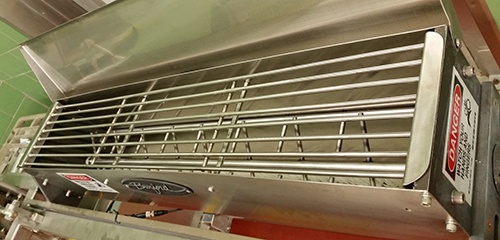
Machine guarding is often thought of as something associated with industry and manufacturing plants. It is true that the potential for hazards from machines is greater in those settings. But even in our homes we often have machines where safety guards have become common. Our garage doors have sensors so that if anything cuts the plane of the door the opener will reverse the action and open the door. Riding lawnmowers have seat interlocks to shut down the engine when we get off the mower. Table saws have sensors to shut the blade off quickly if it comes in contact with a finger. And even kitchen appliances like a food processor have interlocks to keep clumsy home operators from cutting their fingers.
In the early part of the industrial revolution, the focus was on designing machines that improved production. Operators were left to their own ingenuity in finding ways to keep fingers, legs or arms clear of moving parts and protecting their own lives. Many failed to do this and the accident rate of industrial accidents was high. The initial focus of the industrial safety began in the early 1900s. There was a wide public awareness created, and public outrage aroused in 1908 when the Russell Sage Foundation documented the crippling of over 500 workers and the deaths of 526 in Pittsburgh during just that year. Because of public outcry, new laws were created to protect workers and the National Safety Council was created. There was a steady improvement in workplace safety. This was improved even more dramatically when, in 1971, OSHA was established. And there has been dramatic improvement made over the last 40 years. In part the improvements have come because of the concern and caring of employers for their employees. And in part this is caused by the fear of fines and fear of litigation.
{{cta(‘a2b76997-dfbe-4cf5-a5fa-361ab4409620’)}}
The sophistication of machine guarding has continued to improve with newer technologies. The most traditional type of safety guarding was a physical barrier, either fixed or adjustable which prevents fingers or hands from being placed in the proximity of moving parts. This is the simplest and most cost-effective approach. But light curtains, proximity sensors and other types of presence sensing may be less expensive and an attractive alternative. Pull cords and ESTOP buttons are often integrated into the safety system to allow operators to quickly shut down a machine when they see a hazard not prevented by the other machine guards. We’ve been designing, installing and upgrading machine guarding systems for our industrial clients with increasing frequency lately. Bringing machines into compliance with OSHA standards and with workers’ safety in mind is a manufacturing trend that we can all get behind.
Safety programs are a major focus of industrial firms. Training, awareness and safety talks are held regularly. Days without an accident are posted and celebrated. Optimation is an industrial design firm that is proud of its effective safety program and the over 600 days we have had since our last lost time incident. Unfortunately, in our homes, we don’t generally have the same level of awareness to hazards or trying to prevent them. Shop accidents and ladder falls are far more common in homes than at work, even though the hazards present are fewer and lower risk. It’s up to each of us to use and not disable safety devices and machine guards placed on the tools and appliances we buy and use. Someone who had our wellness in mind developed and installed them.
{{cta(‘e7752915-6f45-4b3d-bda6-cb9801be4e1d’)}}
